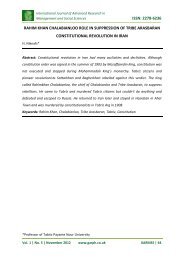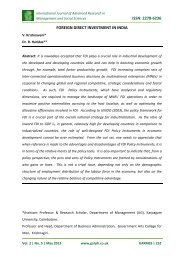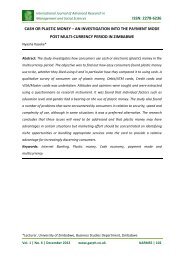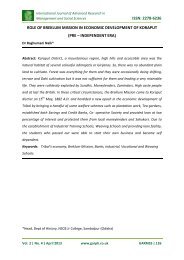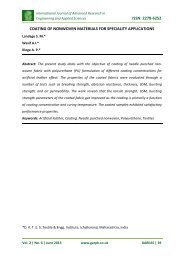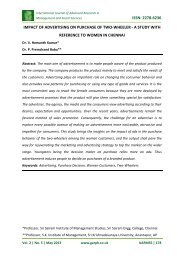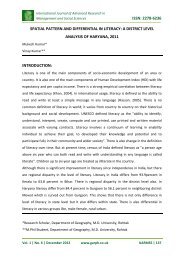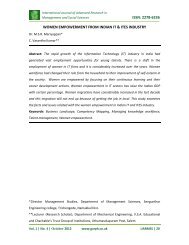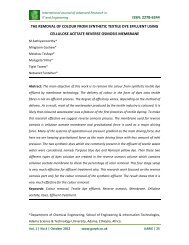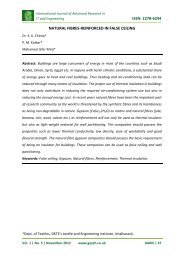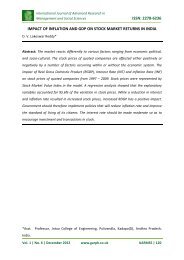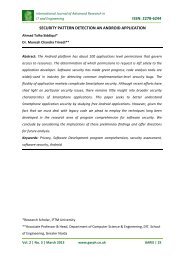WOMEN IN THE WORK PLACE – BPO INDUSTRY - Garph.co.uk
WOMEN IN THE WORK PLACE – BPO INDUSTRY - Garph.co.uk
WOMEN IN THE WORK PLACE – BPO INDUSTRY - Garph.co.uk
Create successful ePaper yourself
Turn your PDF publications into a flip-book with our unique Google optimized e-Paper software.
International Journal of Advanced Research in<br />
Management and Social Sciences ISSN: 2278-6236<br />
C. M. Sudha Arogya Mary*<br />
<strong>WOMEN</strong> <strong>IN</strong> <strong>THE</strong> <strong>WORK</strong> <strong>PLACE</strong> <strong>–</strong> <strong>BPO</strong> <strong>IN</strong>DUSTRY<br />
Abstract:<br />
WOMAN <strong>IN</strong> <strong>THE</strong> ECONOMY<br />
Women are not only the backbone of nuclear and joint family but also the national e<strong>co</strong>nomy.<br />
They are the fulcrum, foundation upon which the super edifice of any family and the<br />
e<strong>co</strong>nomy built upon. The future of any e<strong>co</strong>nomy with special reference to socio-e<strong>co</strong>nomic,<br />
religious and cultural development of the family and the nation depends upon the women<br />
folk.<br />
<strong>WOMEN</strong> PERSONALITY<br />
There cannot be any two different opinions as to the personality of women. They always<br />
have an edge over others especially their <strong>co</strong>unter part viz men. It is an acknowledged truth<br />
that woman are the best.<br />
PREFERENCE OF <strong>WOMEN</strong><br />
One of the appreciable, salient and worth mentioning point to accept by every body is the<br />
preference and forbearance of women. Many have proved beyond doubt that women have<br />
the capability and the capacity to handle any issue / problem in a smooth and amicable way.<br />
For the <strong>BPO</strong> job women are the best to answer, clarify any query/doubt raised by the client<br />
by their sweet voice and polite way of putting things. Above all, recently Ms. Sunitha William<br />
has proved to the world that women are capable of achieving the goal. This paper tries to<br />
highlight the prospects and problems of women in their work place and the suitability of<br />
women for the <strong>BPO</strong> industry.<br />
Keywords: Problems, personality, prospects and preference.<br />
*Asst. Professor, Department of Management Studies, Jaya Engineering College,<br />
Thiruninravur, Chennai<br />
Vol. 1 | No. 1 | July 2012 www.garph.<strong>co</strong>.<strong>uk</strong> IJARMSS | 117
International Journal of Advanced Research in<br />
Management and Social Sciences ISSN: 2278-6236<br />
<strong>IN</strong>TRODUCTION TO OUTSOURC<strong>IN</strong>G<br />
In a global market place, managing a business is increasingly be<strong>co</strong>ming <strong>co</strong>mplex as it pulls<br />
the <strong>co</strong>mpany leaders in many directions, multiplying their responsibilities, dividing their<br />
attention and often hindering their efforts. Competition is also <strong>co</strong>mpelling enterprises to<br />
respond quickly to changing market <strong>co</strong>nditions driven by customer-based valuing of<br />
products and services. So, nowadays <strong>co</strong>mpanies have started to <strong>co</strong>ncentrate on <strong>co</strong>re<br />
<strong>co</strong>mpetency business rather on non-<strong>co</strong>re to their business. Many <strong>co</strong>mpanies have started to<br />
go for outsourcing for their non-<strong>co</strong>re activities. Outsourcing provides an efficient and <strong>co</strong>steffective<br />
for the work to be carried out for <strong>co</strong>mpanies. This trend has recently be<strong>co</strong>me very<br />
popular in both big and small <strong>co</strong>mpanies. The main reason is to attain e<strong>co</strong>nomies of scale.<br />
The <strong>co</strong>mpanies need not build infrastructure of their own because of the above advantage.<br />
<strong>IN</strong>TERNATIONAL SCENARIO OF OUTSOURC<strong>IN</strong>G<br />
The staffing industry internationally has seen a growth rate of 20% p.a. In the past two years<br />
25 million <strong>co</strong>ntract staff is placed in major <strong>co</strong>mpanies. Internationally there are many<br />
outsourcing <strong>co</strong>mpanies are specialized in “Interim Staffing” and “Managed Services”. Major<br />
outsourcing of engineers <strong>co</strong>mes from Information Technology. The major players in the<br />
International markets are Adec<strong>co</strong>, Manpower, VIDIOR,Randstad, Kellys, Spherion<br />
Corporation, Robert Half PLC, Volt Staffing, CSG,CDI, Modis Professional.<br />
NATIONAL SCENARIO OF OUTSOURC<strong>IN</strong>G<br />
It is the single largest segment among all HR services. The market is supposed to grow to a<br />
$2 billion worth than that of the actual of $12-15 billion. It provides more employment<br />
opportunities. Recent statutory changes facilitate flexible outsourcing. India is strongly<br />
positioned in the areas like technical skills relating to IT, Process, Power and Infrastructure,<br />
Life Sciences and Agro-Business.<br />
BENEFITS OF OUTSOURC<strong>IN</strong>G<br />
Free the resources and focus on the strategy improves the processes and save money will<br />
increase the capabilities to start new projects quickly.<br />
IMPORTANCE OF <strong>THE</strong> STUDY<br />
As it has been highlighted as one of the major sector, it is facing lot of problems relating to<br />
stress, health and work place issues, etc. Hence a research is under taken in two of the<br />
Vol. 1 | No. 1 | July 2012 www.garph.<strong>co</strong>.<strong>uk</strong> IJARMSS | 118
International Journal of Advanced Research in<br />
Management and Social Sciences ISSN: 2278-6236<br />
leading ITES Company in Chennai city to find out the major reasons for problems of women<br />
in workplace.<br />
SCOPE OF <strong>THE</strong> STUDY<br />
The study can <strong>co</strong>nfined to <strong>BPO</strong> <strong>co</strong>mpanies in Chennai city. Xansa<strong>–</strong>Sruchery, Sip<strong>co</strong>t Industry<br />
Park, Accenture <strong>–</strong> Solinganalur. The survey is made in these <strong>co</strong>mpanies to find out the major<br />
reasons for problems of women in workplace.<br />
OBJECTIVES OF <strong>THE</strong> STUDY<br />
• To know the benefits provided by <strong>co</strong>mpany for women employees.<br />
• To find the problems faced by women in the <strong>BPO</strong> industry.<br />
• To suggest and re<strong>co</strong>mmend the ways and means for the development of women in<br />
the workplace.<br />
METHODOLOGY<br />
The study has been based on primary and se<strong>co</strong>ndary data. Questionnaire was prepared and<br />
followed. Various books offering information about <strong>BPO</strong> industries also said to be used in<br />
the study. The sample taken for research is 120. Research design used is descriptive<br />
research design and sample design is stratified random sampling.<br />
REVIEW OF LITERATURE<br />
• B.Mythili (2008) in her article titled “Stress among working women” reveals that<br />
policies, program and seminars cannot change the society towards working women.<br />
The society should re<strong>co</strong>gnize the creativity and entrepreneurship of passive and<br />
defense less poor women”.<br />
• Sujatha Mellacheruv (2008) in their article titled “A study on Home related pressures<br />
of working women” states that women as a part of the workforce and gaining<br />
re<strong>co</strong>gnition and choosing challenging careers .As a result ,they face a variety of<br />
pressures at home as well as at work place. Home related pressures are high in case<br />
of women who needed to take care of either younger children or elderly family<br />
members back home. On the other hand, women with grown up children and who<br />
enjoy support from the family members have less pressures. To deal with home<br />
related pressures these women adapt a variety of <strong>co</strong>ping strategies<br />
Vol. 1 | No. 1 | July 2012 www.garph.<strong>co</strong>.<strong>uk</strong> IJARMSS | 119
International Journal of Advanced Research in<br />
Management and Social Sciences ISSN: 2278-6236<br />
• Sucharita, (2008) in her paper titled some <strong>co</strong>mpanies have anti-sexual harassment<br />
and anti-discrimination among polices and also put in place proper reporting<br />
mechanism as well.” A few <strong>co</strong>mpanies have begun to en<strong>co</strong>urage work-from-home,<br />
part-time and tele-working. For working mothers, childcare, sabbaticals and flexible<br />
rejoining policies (especially after a one-year break in service) are being included.<br />
Companies do not want to let go of good experience and do not want to waste<br />
talent.<br />
• Arun Bhatia and Rashmi Bhatia (2007) in their paper titled “Stress at work and How<br />
to manage it” explain about stress. Stress can be both positive and negative, which<br />
has an impact on the employee’s performance at work. If taken positively, the<br />
results are positive, and if taken in a negative way, may yield disastrous results.<br />
• Dr.P.Akbar Batcha (2007) in their paper titled “Problems of women employees in<br />
Call Centres” feels that the women employees in call centers should enjoy all rights<br />
of the working women and not to be treated as slaves. Employers and male<br />
<strong>co</strong>lleagues, including the drivers of vehicles who ferry home at nights should be<br />
sensitized on human rights and dignity of individuals, particularly that of their<br />
women <strong>co</strong>lleagues.<br />
• Nadeem Inamdar (2007) in her paper titled “Safety rules stand widely ignored in<br />
city” views that in Safety rules stand widely ignored in city .A guard should<br />
ac<strong>co</strong>mpany a woman employee for night pick-up (starting 8 pm) and before 6 am<br />
.Men should be picked up first and then the women staff .While dropping them off,<br />
the women should be dropped first and then the men .Woman employee are not<br />
allowed to sit on the front seat next to the driver .<br />
DATA ANALYSIS<br />
Table 1 showing respondents opinion about preference of shift<br />
S.No<br />
Opinion of the No of<br />
Analysis in %<br />
Respondents respondents<br />
1 Dayshift 69 57.5<br />
2 Nightshift 51 42.5<br />
TOTAL 120 100<br />
Vol. 1 | No. 1 | July 2012 www.garph.<strong>co</strong>.<strong>uk</strong> IJARMSS | 120
International Journal of Advanced Research in<br />
Management and Social Sciences ISSN: 2278-6236<br />
57.5 % of the employees feel that they prefer only day shift and 42.5 % feels that they<br />
prefer night shift.<br />
Table 2 showing respondents opinion about getting nightshift allowance<br />
S.No Opinion of the No of respondents Analysis in %<br />
Respondents<br />
1 Yes 96 80<br />
2 No 24 20<br />
TOTAL 120 100<br />
From the above table we can <strong>co</strong>nclude that 80% of the employees feel that they are getting<br />
night allowance, 20% of the employees feel that they are getting night allowance<br />
Table 3 showing respondent’s opinion about enjoying benefits provided by the <strong>co</strong>mpany<br />
S.No Opinion of the No of respondents Analysis in %<br />
Respondents<br />
1 ESI 15 12.5<br />
2 Medical 54 45<br />
3 House Allowance 6 5<br />
4 Maternity leave 24 20<br />
5 Gratuity 18 15<br />
6 LIC 3 2.5<br />
7 Other - -<br />
TOTAL 120 100<br />
From the above table we can <strong>co</strong>nclude that 45% of the employees feel that they are getting<br />
medical benefits, 20% of the employee feel that they are getting maternity leave, 15%<br />
gratuity benefits.<br />
Table 4 showing respondent’s opinion about any problem in ac<strong>co</strong>unt of nightshift<br />
S.No Opinion of the Respondents No of respondents Analysis in %<br />
1 Always 6 5<br />
2 Sometime 54 45<br />
3 Rarely 30 25<br />
4 Never 30 25<br />
TOTAL 120 100<br />
Vol. 1 | No. 1 | July 2012 www.garph.<strong>co</strong>.<strong>uk</strong> IJARMSS | 121
International Journal of Advanced Research in<br />
Management and Social Sciences ISSN: 2278-6236<br />
From the above table we can <strong>co</strong>nclude that 75% of the employees feel that they have<br />
problem in ac<strong>co</strong>unt of nightshift.<br />
Table 5 showing respondent’s opinion about health problem because of nightshift<br />
S.No Opinion of the No of respondents Analysis in %<br />
Respondents<br />
1 A Lot 78 65<br />
2 To some extent 30 25<br />
3 Not at all 12 10<br />
TOTAL 120 100<br />
From the above table we can <strong>co</strong>nclude that 65% of the employees feel that they have lot of<br />
health problem because of nightshift.<br />
Table 6 showing respondent’s opinion about symptoms experienced by the result of<br />
nightshift<br />
S.No Opinion of the Respondents No of respondents Analysis in %<br />
1 Backache 60 50<br />
2 Feeling depressed 6 5<br />
3 Continual tideness 9 7.5<br />
4 Frequent <strong>co</strong>ld and headache 3 2.5<br />
5 Digestive disorder 3 2.5<br />
6 High blood pressure 12 10<br />
7 Feel angry and irritated 3 2.5<br />
8 Sleep difficulty 18 15<br />
9 Respiratory illness 6 5<br />
10 Other - 0<br />
TOTAL 120 100<br />
From the above table we can <strong>co</strong>nclude that 50% of the employees feel that they<br />
experienced Backache by the result of nightshift<br />
Vol. 1 | No. 1 | July 2012 www.garph.<strong>co</strong>.<strong>uk</strong> IJARMSS | 122
International Journal of Advanced Research in<br />
Management and Social Sciences ISSN: 2278-6236<br />
Table 7 showing respondent’s opinion about women who have left their jobs due to<br />
difficulties faced during nightshift<br />
S.No Opinion of the Respondents No of respondents Analysis in %<br />
1 1 9 7.5<br />
2 2 12 10<br />
3 3 18 15<br />
4 4 & above 81 67.5<br />
TOTAL 120 100<br />
From the above table we can <strong>co</strong>nclude that 67.5% of the employees feel that there are<br />
above 4 employees left their jobs due to difficulties faced during nightshift<br />
Table 8 Showing respondent’s opinion about women experiencing stress during work.<br />
S.No Opinion of the No of respondents Analysis in %<br />
Respondents<br />
1 Shift 9 7.5<br />
2 Working <strong>co</strong>ndition 18 15<br />
3 Leave 18 15<br />
4 Timing 54 45<br />
5 Colleague 12 10<br />
6 Boss 9 7.5<br />
TOTAL 120 100<br />
From the above table we can <strong>co</strong>nclude that 45% of women experiencing stress during work<br />
because of timing.<br />
9. To find any relation between shift and stress experienced by women<br />
Ho: There is no association between shift and stress experienced by women<br />
H1: There is association between shift and stress experienced by women<br />
Vol. 1 | No. 1 | July 2012 www.garph.<strong>co</strong>.<strong>uk</strong> IJARMSS | 123
International Journal of Advanced Research in<br />
Management and Social Sciences ISSN: 2278-6236<br />
Observed Frequency (Oi):<br />
Shift<br />
Working<br />
<strong>co</strong>ndition<br />
Leave<br />
timing<br />
<strong>co</strong>lleagu<br />
e<br />
boss<br />
Dayshift 6 9 18 27 6 3 69<br />
Nightshift 3 6 6 21 9 6 51<br />
Total 9 15 24 48 15 9 120<br />
Total<br />
Expected Frequency (Ei)<br />
Shift<br />
Working<br />
<strong>co</strong>nditio<br />
n<br />
Leave<br />
timi<br />
ng<br />
<strong>co</strong>llea<br />
gue<br />
bos<br />
s<br />
Total<br />
Day 5 9 13 28 9 5 69<br />
shift<br />
Nightshi 4 6 11 20 6 4 51<br />
ft<br />
Total 9 15 24 48 15 9 120<br />
Oi Ei [(Oi-Ei)] 2 [(Oi-Ei)] 2<br />
Ei<br />
15 14 1 0.07<br />
18 13 25 1.92<br />
27 28 1 0.04<br />
12 18 36 2.00<br />
12 17 25 1.47<br />
21 20 1 0.05<br />
15 10 25 2.5<br />
∑ [(Oi-Ei)] 2 = 8.05<br />
Ei<br />
Degree of freedom = (r-1) (c-1) <strong>–</strong> 4<br />
= (2-1) (6-1)-4<br />
= (1) (5) - 4<br />
Degree of freedom = 1<br />
Tabulated value of χ 1 for (2-1) (6-1) - 4= 3.84 for 2 D.F at (0.05) level of significance is<br />
Vol. 1 | No. 1 | July 2012 www.garph.<strong>co</strong>.<strong>uk</strong> IJARMSS | 124
International Journal of Advanced Research in<br />
Management and Social Sciences ISSN: 2278-6236<br />
Calculated value χ 2 = 8.05<br />
Table value χ 1 = 3.84<br />
<strong>IN</strong>FERENCE<br />
Hence, Calculated value > Table value. Reject Null Hypothesis<br />
As the null hypothesis is rejected there is association between shift and stress experienced<br />
by women. This clearly portraits that women are experiencing stress due to the shift.<br />
F<strong>IN</strong>D<strong>IN</strong>GS<br />
1 57.5 % of the employees feel that they prefer only day shift and 42.5 % feels that they<br />
prefer night shift.<br />
2 80% of the employees feel that they are getting night allowance, 20% of the employees<br />
feel that they are getting night allowance.<br />
3 45% of the employees feel that they are getting medical benefits, 20% of the employee<br />
feel that they are getting maternity leave, 15% gratuity benefits.<br />
4 75% of the employees feel that they have problem in ac<strong>co</strong>unt of nightshift.<br />
5 65% of the employees feel that they have lot of health problem because of nightshift.<br />
6 50% of the employees feel that they experienced Backache by the result of nightshift.<br />
7 67.5% of the employees feel that there are above 4 employees left their jobs due to<br />
difficulties faced during nightshift.<br />
8 45% of women experiencing stress during work because of timing.<br />
9 There is association between shift and stress experienced by women.<br />
SUGGESTIONS<br />
1. The organization should <strong>co</strong>ncentrate on the people who achieve and perform well .They<br />
should be re<strong>co</strong>gnized immediately in the form of monetary benefits.<br />
2. Entertainment, <strong>co</strong>nducting cultural programs within organization can be carried out so<br />
that the stress level of the women employees <strong>co</strong>uld be reduced.<br />
3. The top management should refer the wellness of employees while taking decisions.<br />
5. The <strong>co</strong>mpany should provide master health check up and annual treatment if needed.<br />
6. Weekend reassertion club <strong>co</strong>uld be organized to women employees.<br />
CONCLUSION<br />
In this <strong>co</strong>mpetitive world where work environment is filled up with lot of stress and other<br />
problems the organizations should take care of its employees because they are not just<br />
Vol. 1 | No. 1 | July 2012 www.garph.<strong>co</strong>.<strong>uk</strong> IJARMSS | 125
International Journal of Advanced Research in<br />
Management and Social Sciences ISSN: 2278-6236<br />
people who <strong>co</strong>me and work but the best results are performed by them hence the<br />
organization should take a note of its employees welfare too.<br />
Benefit to the society:<br />
Women who are the moulds of the family to create the future generation must be free of<br />
stress. There is a chance for women to <strong>co</strong>llapse her family due to the work stress. Kids of the<br />
same will behave in an odd manner which affects the society in future. This is the right time<br />
to relieve the stress of women employees so as to create a peaceful generation in future<br />
without stress.<br />
Further research <strong>co</strong>uld be carried out to check out the behavior of stressful women’s<br />
children and their I.Q level should be studied. So that it would reveal the truth of the result<br />
of the word “Stress” in their mother’s work. Researcher has increased the eagerness to find<br />
the remedies for work stress. This is because, women should be free of stress to carry away<br />
her work and lead a peaceful life<br />
REFERENCES<br />
1. Dr.P.Akbar Batcha is a professor in M.S.S.Wakf Board College, Madurai <strong>–</strong>“Problems<br />
of women employees in Call Centres” in HRD Times vol.9, October 2007, Page No:<br />
21-23.<br />
2. Arun Bhatia is a Senior Lecturer at Amity University U.P and Rashmi Bhatia is a<br />
Assistant Professor at BLS Institute of Management, U.P-“Stress at work and How to<br />
Manage it” ICFAI University press, HRM Review -December 2007 Page No 42-46.<br />
3. Abraham, R (2000). The role of job <strong>co</strong>ntrol as a moderator of emotional dissonance<br />
and emotional intelligence with the out<strong>co</strong>me of relationships. Journal of psychology<br />
[J Psychol], Vol. 134, (2), pp. 169-84.<br />
4. Balas, M. (2004) Unresolved Tension Can Lower Workplace Productivity, Increase<br />
Turnover. Knight Ridder Tribune Business News, p. 1.<br />
5. Chung, B. G., & Schneider, B. (2002). Serving multiple masters: role <strong>co</strong>nflict<br />
experienced by service employees. Journal of Services Marketing, Vol. 16, pp. 70-87.<br />
6. DelBel, J. C. (2003). De-escalating workplace aggression. Nursing Management, Vol.<br />
34, (9), p. 30.<br />
7. Dew, John R. (1998). Go with the flow: Stress and the quality professional. Quality<br />
Progress, 31, 65-68.<br />
Vol. 1 | No. 1 | July 2012 www.garph.<strong>co</strong>.<strong>uk</strong> IJARMSS | 126
International Journal of Advanced Research in<br />
Management and Social Sciences ISSN: 2278-6236<br />
8. Hughes, D . (1994). Work experiences and marital interactions: elaborating the<br />
<strong>co</strong>mplexity of work. Journal of Organizational Behavior, Vol. 15, p. 423.<br />
9. McClure, L. (2000). Anger and <strong>co</strong>nflict in the workplace. VA: Impact Publications<br />
10. Mythili is a Lecturer in Pollachi College “Stress among working women” in HRD Times<br />
vol.10, Sep 2008, Page No: 48.<br />
11. Nierman, L. (1994, March). Managing <strong>co</strong>nflicts without <strong>co</strong>nflict. Food Processing.<br />
12. Occupational Hazards (2004). The Mind-Body Connection: Workplace Conflict, Stress<br />
& the Risk of Injury. Retrieved from the web September 4, 2004. http://www<br />
.occupational hazards.<strong>co</strong>m/ safety_zones/ 48/article.php?id=12168.<br />
13. Phillips, D., Cooke, J., & Anderson, A. (1992). A surefire resolution to workplace<br />
<strong>co</strong>nflicts. Personnel Journal, Vol. 71, pp. 111-115.<br />
14. Noble, C. (2001). Resolving Co-Worker Disputes Through “Coaching Conflict<br />
Management.” Canadian HR Reporter, Vol. 14, (16), pp. 18-20.<br />
15. Dr.sujatha Mellacheruvu, “A study on Home related pressures of working women”<br />
Pratibimba <strong>–</strong> The journal of IMIS, Volume-8, and issue: 1, Januray-June 2008, Page21-28.<br />
Vol. 1 | No. 1 | July 2012 www.garph.<strong>co</strong>.<strong>uk</strong> IJARMSS | 127





